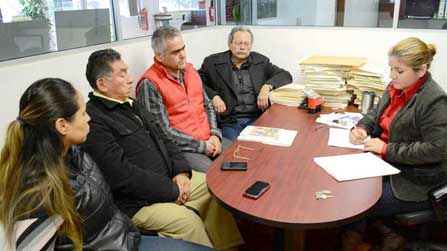Call made for end to burning of asparagus residue in Caborca

Environmental regulations are still being ignored a year after Sindia Anel Gutiérrez Saldaña (right), head of Sagarpa in Sonora, responded to David Silva (red vest) and the members of the NGO Sonora Transparente A.C. that authorities should unite with growers and victims of the burning of asparagus crop residue. (Photo: Julio César Ortega Quiroz y Mora). (Photo: Julio César Ortega Quiroz y Mora).
CABORCA
Although the burning of agricultural crop residue causes severe harm to both human and environmental health, it continues to be common practice across the country and one which no competent authorities are addressing.
A petition to put an end to the practice of burning asparagus stalks in Caborca that layout the problem in detail is circulating on the social networks via Change.org. It is signed by David Silva Bonales and directed to: Municipal President Karina García Gutiérrez; Sonora Public Health Secretary Gilberto Ungson Beltrán; representative from the Agriculture, Livestock, Rural Development, Fish and Food (Sagarpa) Secretariat Jorge Guzmán Nieves; Secretariat of the Environment and Natural Resource representative in Sonora Gustavo Adolfo Claussen Iberri; and the Sonora Governor Claudia Pavlovich Arellano.
“For the last 25 years, during the coldest months of December and January, they have been burning more than 13 thousand acres of esparagus stalks around Caborca, Sonora. During the month long burning, mi family and I suffer constant headaches, sore throats, red eyes, persistent allergies. It’s also impossible to play sports. And we aren’t the only ones. In the region there are enormous columns of smoke from these fires that can even be seen on satellite images. The city is blanketed by smoke and this is what we are all breathing.”
According to one study published by the Commission for Environmental Cooperation (CEC) of the North American Free Trade Agreement, the burning of these residues releases dioxins, listed as persistent bioaccumulative toxicants (PBTs) because they contain chlorine and residues of pesticides absorbed into the tissues of the leaves and stems, as well as beomg the source of 40% of the CO2, 32% of CO, 20% of suspended particulate matter, and 50% of the polycyclic aromatic hydrocarbons emitted into the atmosphere on a worldwide basis.
These substances contribute to climate change because they contain greenhouse gases and other short-lived contaminants like soot, which cause severe harm to human health even in very small amounts. For example, effects are seen as: reduced sperm count in male infants and children; changes in human thryroid hormone levels; neurological effects from in-utero fetal exposure; low testosterone levels; and reproductive problems in women such as decreased fertility, prolonged menstrual cycles and early menopause, among others.
In Caborca the asparagus growers argue that the burning is neccesary to guarantee the high quality of the product. Nonetheless, Peru and China, the largest producers of asparagus in the world do not follow this practice. Neither does Spain. In Mexico’s state of Guanjuato, another big asparagus producer, they don’t burn the residue either. It has been shown scientifically that the burning is not necessary in the growers fields, but they refuse to stop the practice.
The petition that contains over 17,000 signatures states, “We have spoken to the authorities but have not received any real help. We have been fighting for more than 10 years. Even the Municipal President Karina García Gutiérrez has asked us to demonstrate that the smoke is harmful. It should be pointed out that she is a biochemist, and that she should surely know that it is, since the asparagus burning emits large quantities of CO2 into the atmosphere and disperses millions of particles harmful to the respiratory system, all which also does considerable harm to the environment.”
With the asparagus industry, what Caborca gets in return is the environmental contamination since 95% of the economic benefits leave bound for the United States. David Silva concludes, “Because of this, I am asking the Cabora Municipal President to prohibit the burning of asparagus stalks for the well-being of the local population whose health is at constant risk, without mentioning the high incidence of cancer that has exploded in the region in recent years, as well as asthma and acute respiratory illnesses.”
